People
Meet Ariana Papademetropoulos, Who Has Earned a Cult Following From Paintings Awash in Southern California Mysticism
The artist invites viewers into her uncanny universe with a dual show in Los Angeles.
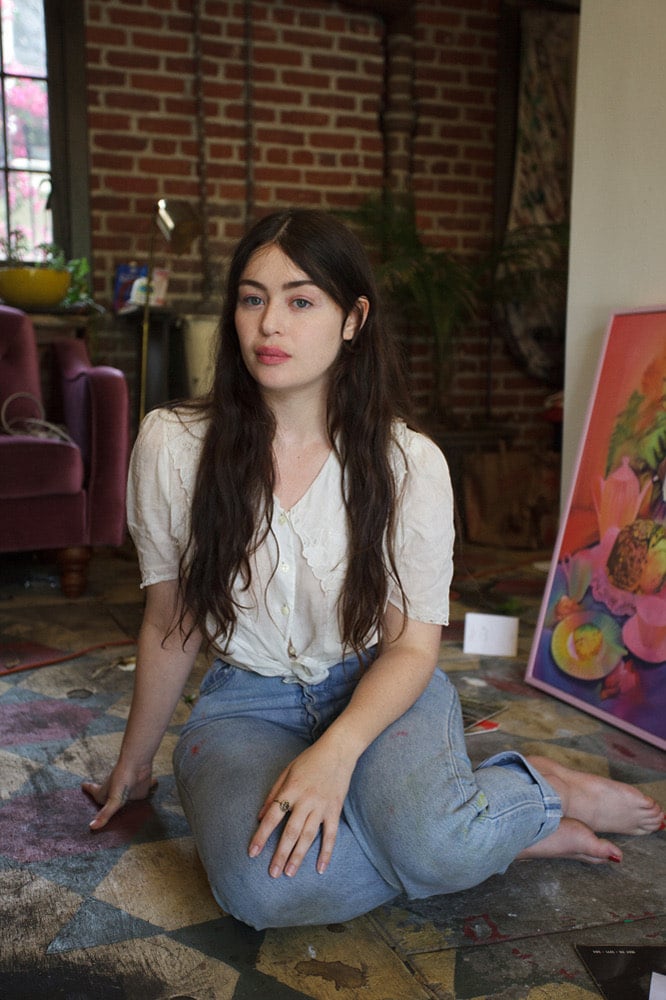
The artist invites viewers into her uncanny universe with a dual show in Los Angeles.

Katie White

Los Angeles artist Ariana Papademetropoulos will lure you into a painted fairy tale—one that hovers winkingly between the romantic and the foreboding. Papademetropoulos, who is 30 and was born and raised in Pasadena, makes seductively beautiful, large-scale paintings that brim with the symbols and attributes of girlhood, Hollywood, and a very Southern California brand of the occult. Four-poster beds, unicorns, and glistening soap bubbles that call to mind Glinda the Good Witch all make appearances. A meticulous technician, Papademetropoulos’s works are often described as hyper-realistic, yet the canvases are the first to signal their own illusory nature, with trompe-l’oeil watermarks or torn edges offering viewers a path into or out of her dreamlike universes.
Over the past decade, she has earned a devoted following. Papademetropoulos graduated from CalArts in 2012 and worked as a studio assistant for the figurative painter Noah Davis; the late artist gave her her first break when he included her in a show he curated at Roberts Projects in Los Angeles in 2010. In 2019, she earned plaudits for a solo exhibition at The Breeder gallery in Athens (Papademetropoulos is of Greek and Argentine descent). Just last year, in 2020, she transformed Vito Schnabel Gallery in New York into a lushly colorful installation with her exhibition “Unweave a Rainbow.”
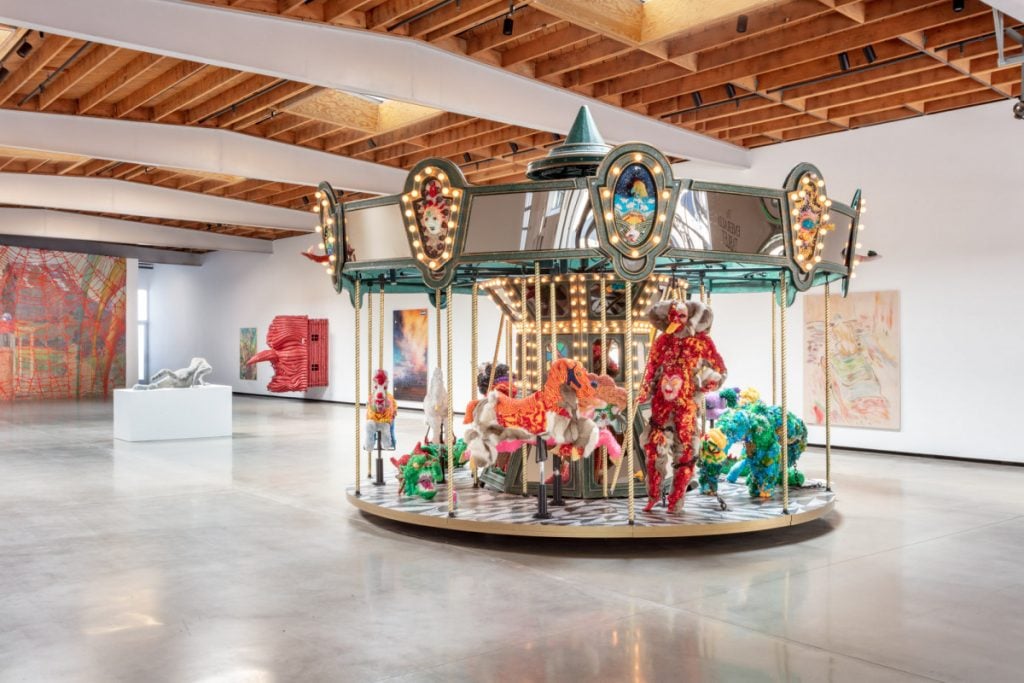
Installation view of “The Emerald Tablet,” curated by Ariana Papademetropoulos, 2021. Photo: Joshua White. Courtesy of Jeffrey Deitch Gallery.
Now, Papademetropoulos is showcasing her recent paintings in the “The Emerald Tablet” at Jeffrey Deitch Los Angeles, a two-part show that also includes a group exhibition she curated. The entirety is thematically inspired by Frank Baum’s book The Wizard of Oz and the Emerald Tablet of Hermes, the theosophical text about alchemy said to have inspired Baum’s acclaimed story.
Papademetropoulos’s own surreal visions here interact with a dizzying array of voices. Raúl de Nieves’s fur- and gem-covered carousel at the center of the gallery sets a carnivalesque tone. There are also works by Mike Kelley, Isabelle Albuquerque, and even the musician Beck. Papademetropoulos aligns herself in a tradition of mystical women artists; fittingly, there is a work by Agnes Pelton, the early 20th-century transcendental California artist, as well as a painting by midcentury Los Angeles occultist Marjorie Cameron (who went simply by Cameron).
Recently, we spoke with Papademetropoulos over Zoom. She was outside at a turtle conservancy in Ojai, California, and wearing a rainbow bikini top and shorts. Large mushroom sculptures were visible in the background behind her. As in many instances, Papademetropoulos seemed to appear as both muse and maker in an uncanny world (for the curious, her delightful Instagram account is worth exploring).
You’ve been painting since you were very young; I know you attended the Los Angeles County High School for the Arts. How did you get your proverbial start?
Painting has always been it for me, it’s not something I came to later. Everyone in my family are architects, and because of that I’ve always had an interest in space. I wanted to be an architect, actually, but my family encouraged me to be an artist because you have more freedom to make spaces what you want them to be. Installation is still so important to my work because of that, as is scale. I’ve always wanted to go bigger and more enveloping than a typical-size painting and add in elements of installation so that it can create a kind of atmosphere. I’ve also worked for many artists—Noah Davis, Jonah Freeman and Justin Lowe, Jim Shaw, and Marnie Weber—which is cool because they’re all in this show.
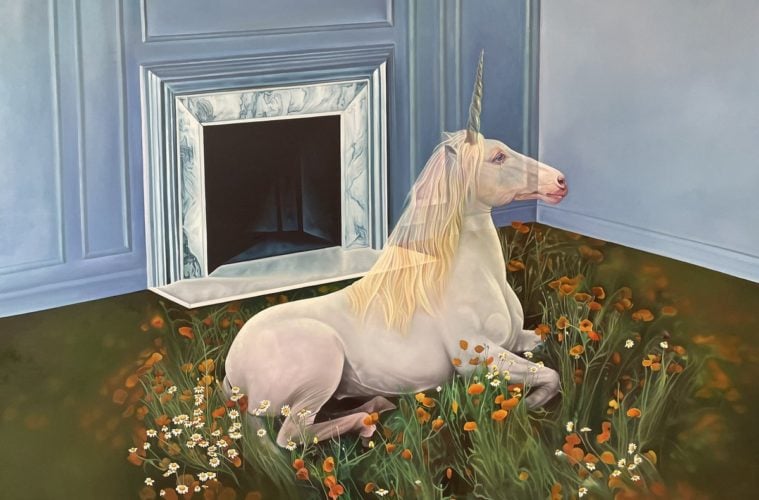
Ariana Papademetropoulos, The Tamed Beloved (2021). Courtesy of Jeffrey Deitch Gallery.
You often paint from found imagery. Can you tell me about your process for the works in “The Emerald Tablet” specifically?
All the paintings start from a source image, yes. For this show, it mostly was all vintage postcards, ranging from the 1920s to the ’60s. I collect books. I love interior design books. Each painting is such a different type of process and they all take so much time. For instance, the exhibition includes a painting with a boat. I was thinking about making that boat painting like, three years ago. In that case, I just had a picture that I found in National Geographic of a man in a boat, and I just put it on my wall and kept coming back to it. I collect a lot of source imagery and I just kind of wait until it’s the moment. But it all comes from real postcards and physical images. I feel like the internet is too vast for me to figure out in terms of researching images. I need the boundaries of it coming from a real place. I can connect ideas more and become more creative, in a way.
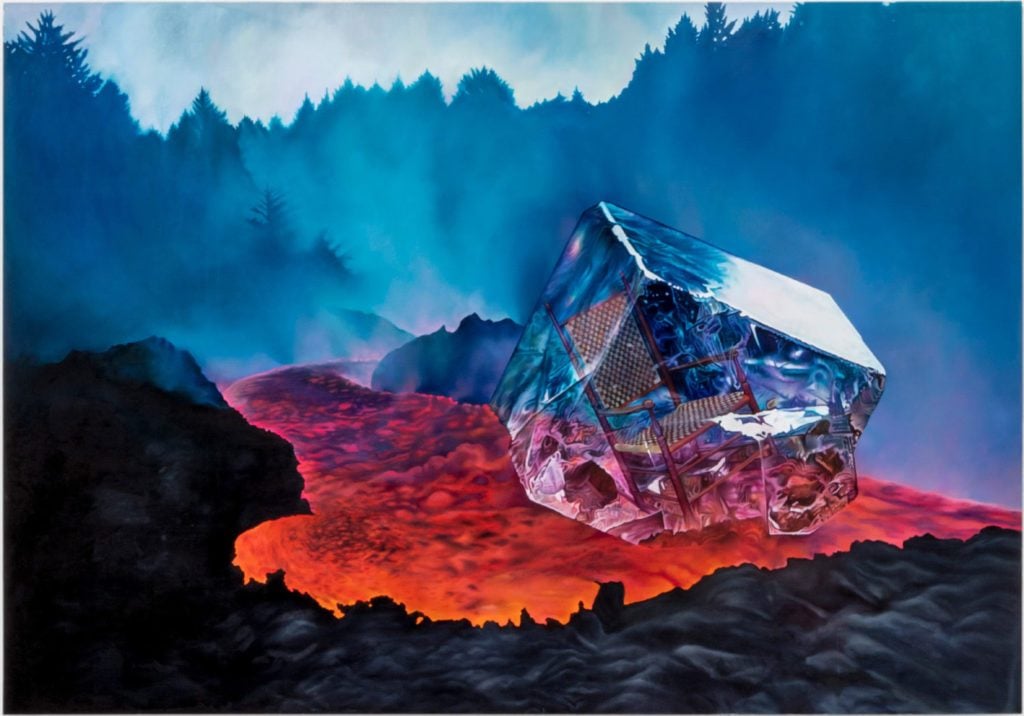
Ariana Papademetropoulos, A Mellow Drama (2021). Courtesy of Jeffrey Deitch Gallery.
Your paintings are often of lavish domestic spaces or fairy-tale places. They’re very pretty, but there is also something a little bit spooky or even disturbing even sometimes.
I try to use beauty as a portal to get somewhere else. It’s all about balance. And I try to find that balance between femininity, masculinity, dark, light, and magic, but not too much magic. Those access points draw people in. At first glance, the response can be ‘Magic!’, but then I try to pull back and not go too far into any one realm. What draws me to an image is mystery, when I never fully understand it. I try to keep that tension. If I can keep looking at it and I feel like it keeps changing, then OK, that is a good painting.
Your subject matter often includes bedrooms or living spaces. Why is that?
I like the idea of the domestic place as a site for imagination. For this show, the reason I was so interested in The Wizard of Oz and the home is that home is always supposed to be the safe place—but it’s actually this place that, while we’re secure and safe, maybe where fantastical things happen, too. I love the idea of being caught up in a cyclone.
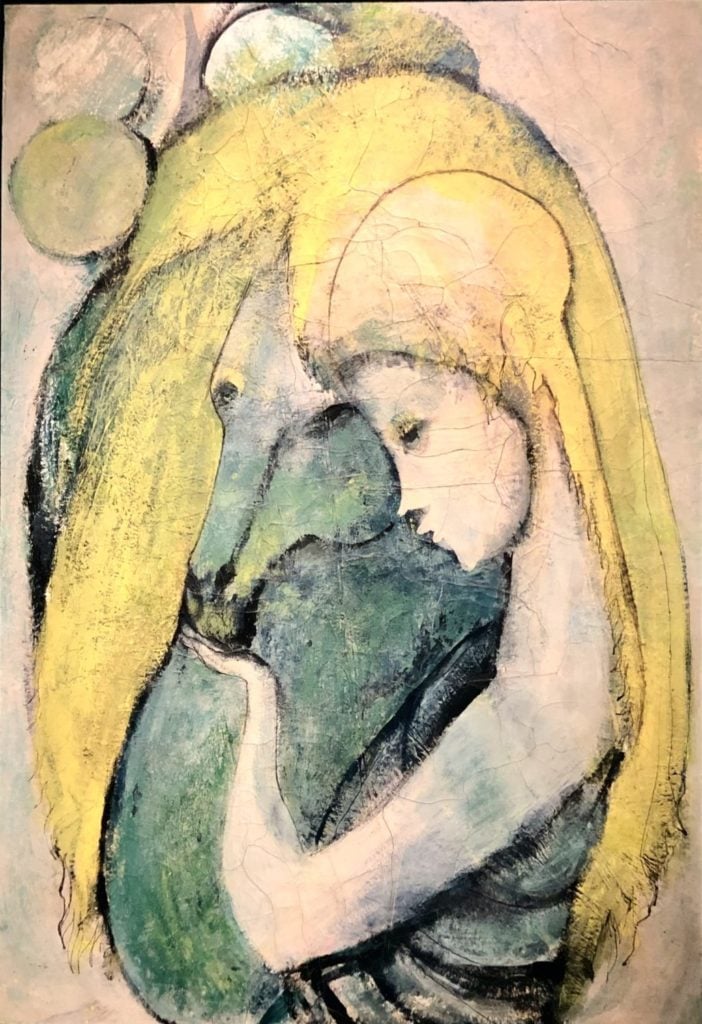
Cameron, Sun Horse (1952). Courtesy of Jeffrey Deitch Gallery.
Speaking of “The Emerald Tablet,” what was the genesis of the idea to simultaneously present your new works and curate a group exhibition?
Originally it was meant to be a solo show, but that space is so massive that I told Jeffrey [Deitch], ‘I don’t think I can fill the whole space.’ He encouraged me to curate the show so that I could create my whole universe. Jeffrey has always believed that I’m more than a painter, someone who creates worlds.
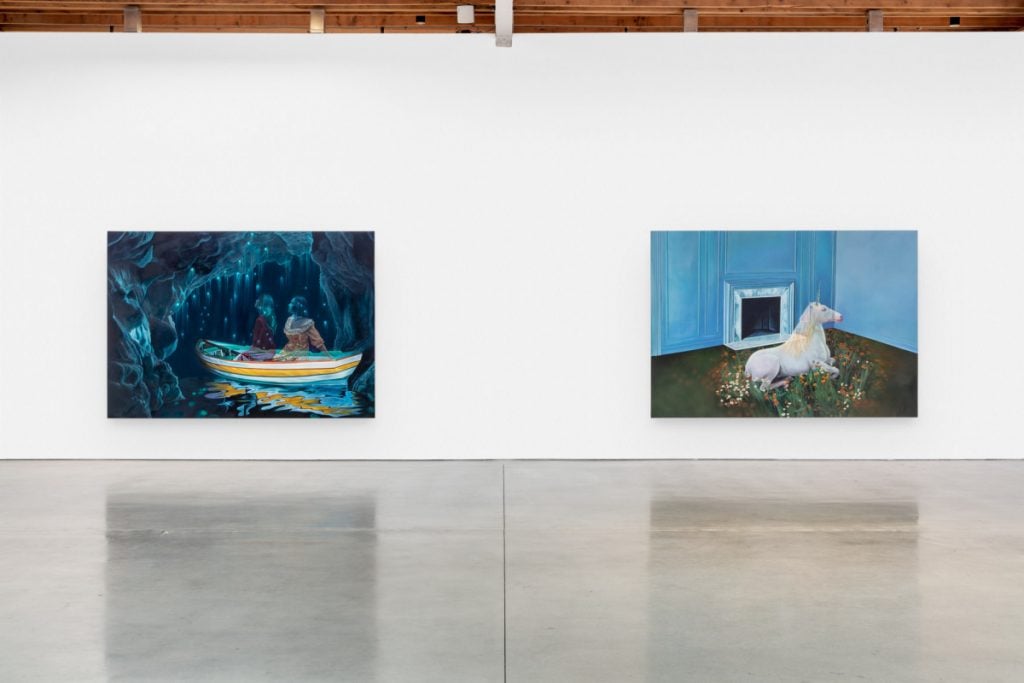
Installation view of “The Emerald Tablet,” 2021. Photo: Joshua White. Courtesy of Jeffrey Deitch Gallery.
How did you select the artists for the group show?
At first I just wrote down all my favorite artists, from historical to contemporary, and I tried to figure out the common thread that tied them all together. A lot of them are exploring in-between states and metamorphosis, but I didn’t want to do a show on metamorphosis. Metamorphosis took me into alchemy, then from alchemy, I came across the title “The Emerald Tablet.” And that hit something. I thought it sounded like the Emerald City from the Wizard of Oz. I found out that Frank Baum, who wrote the Wizard of Oz, was a theosophist. One of the major theosophy centers is in Pasadena, where I’m from. It felt very cosmic—I went way far out into alchemy and then I was brought back to where I’m from, to Hollywood cinema and all the things I’m interested in. Agnes Pelton was already on my list. She was a theosophist, and the show includes one of her spiritualist landscapes. While many of the artists in the show never knew each other, there is a sort of visual collective unconscious over time: there’s Theodora Allen, who didn’t know who Pelton was, but their work has similarities, and so on. The show is supposed to be this journey that leads you to someplace that exists within all of us.
What’s next? I’ve heard rumors that you might be doing an exciting installation in Italy…
I can’t say too much, but I’m going to be working on a very big project with a museum in Italy. I’ll be building a grotto, like a nymphaeum—my dream!
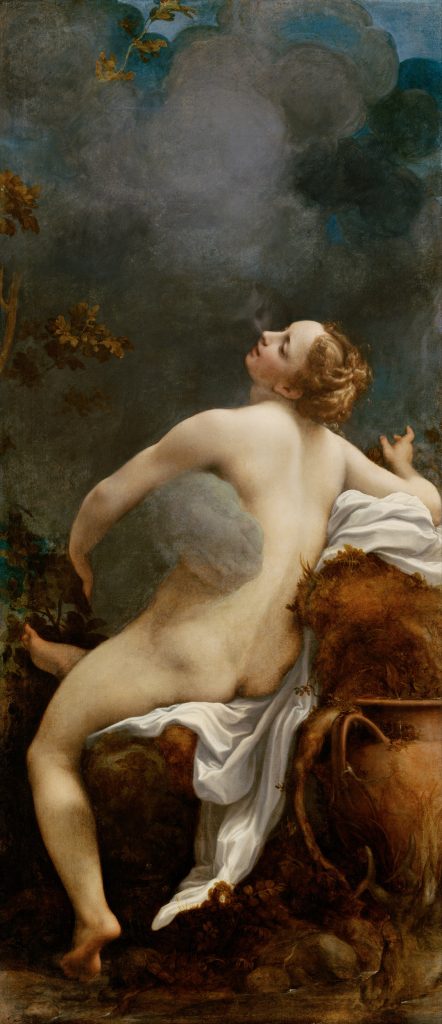
Antonio da Correggio, Jupiter and Io (circa 1530). Collection of the Kunsthistorisches Museum, Vienna.
Last question: If you could own any work of art, what would it be?
Antonio da Correggio’s Jupiter and Io (ca. 1530) has everything to me. That painting is collapsing many different realities and converging of realms of the erotic and the supernatural. It’s a painting that feels like it never ends—there’s a hand, and then you see the lips.
“The Emerald Tablet: A Solo Exhibition and Curatorial Project by Ariana Papademetropoulos” is on view through Saturday, October 26, at Jeffrey Deitch Gallery Los Angels, 925 N. Orange Drive, Los Angeles